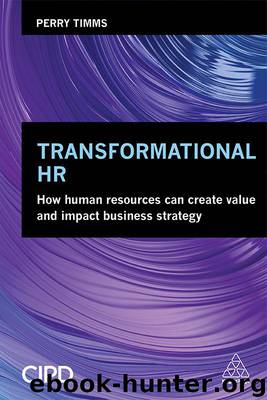Transformational HR: How Human Resources Can Create Value and Impact Business Strategy by Timms Perry

Author:Timms, Perry [Timms, Perry]
Language: eng
Format: azw3
Publisher: Kogan Page
Published: 2017-10-03T04:00:00+00:00
Time to transform the HR business partner role?
Why do I think we need a book about transformational HR when Professor Ulrich’s model clearly allows for change and adaptation to be a part of the modus operandi of HR? I think to unhook our habits and orthodoxies in HR we need to consciously create something new, something transformational for HR and allow and direct HR to be more transformational in the businesses it works with.
For starters, we’ve already explored in this book how the world is changing in ways that simply weren’t envisaged in 1997. Or even in 2007. We’ve also been through a great recession that has shifted some of our perspectives on safe, secure and even smart ways to work. Public sector cuts, austerity and a gap in the wealthiest to the poorest hasn’t helped us mend societal rifts through enterprise, work and meaning. We’ve also simply learned more about ourselves. Our health and wellbeing for example. Our community spirit or otherwise, how the brain works and the discovery of new medicines, materials and methods of working.
So the 1996 Ulrich – or HR business partner – model was conceived in a different age. And yet bizarrely, we’ve rarely adapted the model ourselves as a profession. Not everyone of course, but there’s a majority view that the shared services, centre of excellence and business partner triage is the solution in almost all corporate worlds.
The version of a changing entity in organizational life has largely been the ‘R’ word – restructuring. I’ve experienced countless of these – many seemed to tackle systemic problems some even shifted to make a toxic leader redundant and not tackle their poor performance as a leader.
Yes, we’ve seen endless corporate restructures brought about by mergers, shifts in the market, the need to downsize (or even worse, a phrase I detest – right-size) and the almost fixated view that we unfreeze, change and then refreeze from Kurt Lewin’s famous change model. One I feel has had it’s day and is no longer as relevant in the fluid world we live in now. We appear to have seen very little design for adaptability or fluid states of being that are in need of no restructure and are a constantly reshaping and agile state of being.
The technology industry of course has a lot to offer to HR (as I’ve already mentioned) and yet not much crossing over of methodologies has naturally occurred. The technology industry has recovered from huge projects and failures during the 1990s into the dot com boom and bust of the early 2000s into the giants of success we now see. I don’t even need to name the companies as their market capitalization and value is astounding.
The technology industry was, in my experience, the first to adopt a model similar to Professor Ulrich’s own. I worked in this way in the early-mid 1990s before the Ulrich model was conceived and so when the model came into HR, I was more than familiar with it.
So I wonder
Download
This site does not store any files on its server. We only index and link to content provided by other sites. Please contact the content providers to delete copyright contents if any and email us, we'll remove relevant links or contents immediately.
Bad Blood by John Carreyrou(6516)
Rich Dad Poor Dad by Robert T. Kiyosaki(6353)
Principles: Life and Work by Ray Dalio(6169)
Playing to Win_ How Strategy Really Works by A.G. Lafley & Roger L. Martin(5848)
Management Strategies for the Cloud Revolution: How Cloud Computing Is Transforming Business and Why You Can't Afford to Be Left Behind by Charles Babcock(4508)
The Confidence Code by Katty Kay(4172)
Thinking in Bets by Annie Duke(4139)
American Kingpin by Nick Bilton(3735)
Delivering Happiness by Tony Hsieh(3352)
Project Animal Farm: An Accidental Journey into the Secret World of Farming and the Truth About Our Food by Sonia Faruqi(3162)
The Power of Habit by Charles Duhigg(3043)
Brotopia by Emily Chang(2986)
The Tyranny of Metrics by Jerry Z. Muller(2978)
Mastering Bitcoin: Programming the Open Blockchain by Andreas M. Antonopoulos(2964)
The Marketing Plan Handbook: Develop Big-Picture Marketing Plans for Pennies on the Dollar by Robert W. Bly(2947)
I Live in the Future & Here's How It Works by Nick Bilton(2919)
The Content Trap by Bharat Anand(2850)
Applied Empathy by Michael Ventura(2825)
Building a StoryBrand by Donald Miller(2825)
